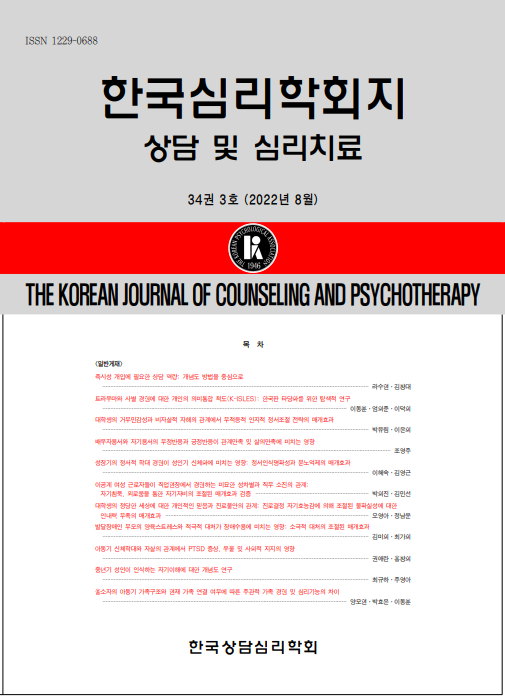open access
메뉴
open access
메뉴 ISSN : 1229-0688
ISSN : 1229-0688
This study examined which aspects of the three elements (goal, task, and bond) in the supervisory working alliance would influence the supervisee's role ambiguity, role conflict, and satisfaction with supervision. In addition, we investigated if the role difficulties and supervision satisfaction would vary based on the supervisee's experience level. This study used the following instruments: The Working Alliance Inventory-Trainee version, Role conflict and Role Ambiguity Inventory, and Trainee Personal Reaction Scale-Revised. The 170 supervisees currently engaged in clinical supervision participated in this study. For data analysis, multiple regression and multivariate analyses were performed. The analysis results revealed that the ‘goal’ and ‘task’ aspects of the supervisory working alliance influenced the supervisees' role ambiguities and role conflicts. However, the ‘bond’ element had no significant effect on theirrole difficulties and satisfaction with supervision. Moreover, the extent of ‘role ambiguity’ varied based on the supervisee's experience level. The mean score of thebeginner counselors on role ambiguity was significantly higher than that of the experienced counselors.
(2005) 개인수퍼비전에서 상담수련생의 비개방 내용 이유 및 방식에 대한 연구 ,
(2005) 수퍼비전 교육내용 요구도와 실태 만족도 연구-숙련과정에 있는 상담자를 중심으로 ,
(2001) 소집단 수퍼비전 만족도에 영향을 미치는 변인 연구,
(2005) 수퍼바이저 스타일이 수퍼비전 과정과 성과에 미치는 영향,
(2003) An introduction to multivariate statistical analysis, Wiley- Interscience.
(1990) Role induction for counselor trainees Effects on the supervisory working alliance, University Microfilms No
(1991) The effects of role induction on trainees' perceptions of supervision,
(2004) Fundamentals of clinical supervision, Allyn & Bacon.
(1983) A working alliance based model of supervisor,
(2000) Relations of complementarity and supervisory issues to supervisory working Alliance: A comparative analysis of two cases,
(1990) Measuring the working alliance in counseling supervision,
(1997) Inferences concerning supervisees and clients in clinical supervision: An integrative review., John Willey & Sons.
(1984) Development and validation of the supervisory styles inventory,
(1981) A study of the interpersonal influence process in supervision,
(1995) Clinical supervision: A systems approach, Sage.
(1983) Patterns of verbal behavior and judgements of satisfaction in the supervision interview,
(1984) Dimensions of satisfaction in the supervision interview,
(1989) Development and validation of the alliance inventory,
(1994) Psychotherapeutic relationship in different cultures Proceedings of 16th International Congress of Psychotherapy,
(2001) Differences making a difference:Cross-cultural interactions in supervisory relationships,
(1988) Perceptions of counselor supervision:An examination of Stoltenberg's model from the perspectives of supervisor and trainee,
(1999) The supervisory working alliance, trainee self-efficacy, and satisfaction.,
(1995) The relationship between the supervisory working alliance and trainees' experience of role conflict and role ambiguity,
(1996) Nature, extent, and importance of what psychotherapy trainees do not disclose to their supervisors,
(1992) Trainees' experience of role conflict and role ambiguity in supervisory relationships,
(1997) Relevance of the supervisory alliance to the counseling alliance and to treatment adherence in counselor training,
(2002) Negative supervisory events: Effects on supervision satisfaction and supervisory alliance.,
(1994) The status of the counseling relationship,
(2000) Psychotherapy with members of Asian American churches and spiritual traditions., American Psychological Association.
(1997) Defining psychotherapy supervision and understanding, John Willey & Sons
(1981) International and American student's expectations about counseling,
(1981) International and American student's expectations about counseling,
